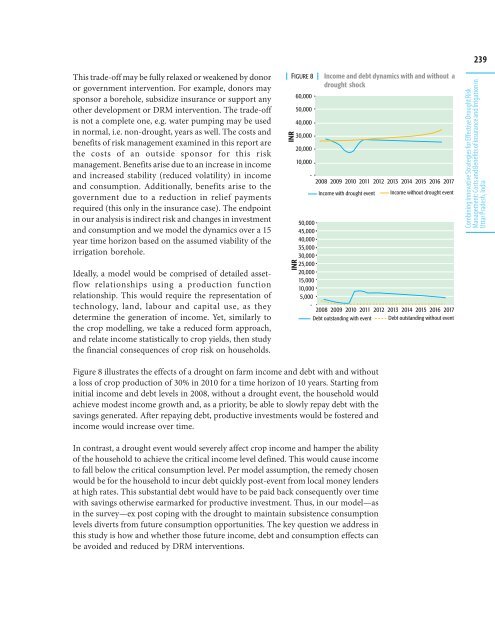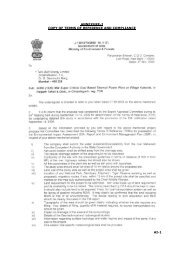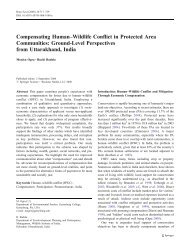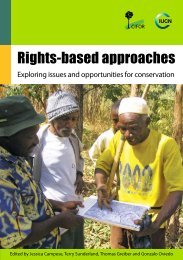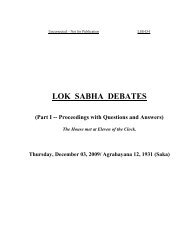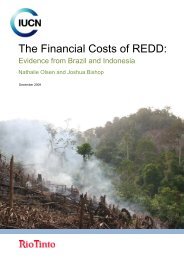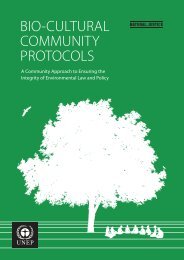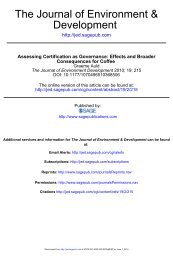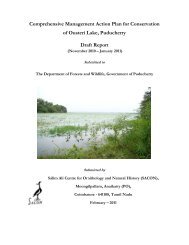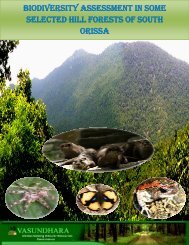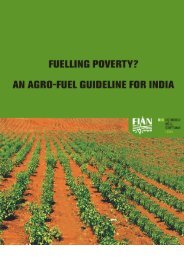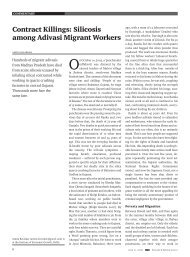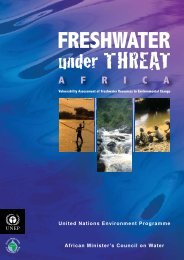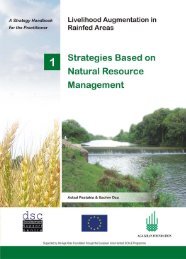Catalyzing Climate and Disaster Resilience: Processes for Identifying
Catalyzing Climate and Disaster Resilience: Processes for Identifying
Catalyzing Climate and Disaster Resilience: Processes for Identifying
Create successful ePaper yourself
Turn your PDF publications into a flip-book with our unique Google optimized e-Paper software.
239<br />
This trade-off may be fully relaxed or weakened by donor<br />
or government intervention. For example, donors may<br />
sponsor a borehole, subsidize insurance or support any<br />
other development or DRM intervention. The trade-off<br />
is not a complete one, e.g. water pumping may be used<br />
in normal, i.e. non-drought, years as well. The costs <strong>and</strong><br />
benefits of risk management examined in this report are<br />
the costs of an outside sponsor <strong>for</strong> this risk<br />
management. Benefits arise due to an increase in income<br />
<strong>and</strong> increased stability (reduced volatility) in income<br />
<strong>and</strong> consumption. Additionally, benefits arise to the<br />
government due to a reduction in relief payments<br />
required (this only in the insurance case). The endpoint<br />
in our analysis is indirect risk <strong>and</strong> changes in investment<br />
<strong>and</strong> consumption <strong>and</strong> we model the dynamics over a 15<br />
year time horizon based on the assumed viability of the<br />
irrigation borehole.<br />
Ideally, a model would be comprised of detailed assetflow<br />
relationships using a production function<br />
relationship. This would require the representation of<br />
technology, l<strong>and</strong>, labour <strong>and</strong> capital use, as they<br />
determine the generation of income. Yet, similarly to<br />
the crop modelling, we take a reduced <strong>for</strong>m approach,<br />
<strong>and</strong> relate income statistically to crop yields, then study<br />
the financial consequences of crop risk on households.<br />
| FIGURE 8 | Income <strong>and</strong> debt dynamics with <strong>and</strong> without a<br />
drought shock<br />
60,000<br />
INR<br />
INR<br />
50,000<br />
40,000<br />
30,000<br />
20,000<br />
10,000<br />
-<br />
2008 2009 2010 2011 2012 2013 2014 2015 2016 2017<br />
Income with drought event Income without drought event<br />
50,000<br />
45,000<br />
40,000<br />
35,000<br />
30,000<br />
25,000<br />
20,000<br />
15,000<br />
10,000<br />
5,000<br />
-<br />
2008 2009 2010 2011 2012 2013 2014 2015 2016 2017<br />
Debt outst<strong>and</strong>ing with event Debt outst<strong>and</strong>ing without event<br />
Combining Innovative Strategies <strong>for</strong> Effective Drought Risk<br />
Management: Costs <strong>and</strong> Benefits of Insurance <strong>and</strong> Irrigation in<br />
Uttar Pradesh, India<br />
Figure 8 illustrates the effects of a drought on farm income <strong>and</strong> debt with <strong>and</strong> without<br />
a loss of crop production of 30% in 2010 <strong>for</strong> a time horizon of 10 years. Starting from<br />
initial income <strong>and</strong> debt levels in 2008, without a drought event, the household would<br />
achieve modest income growth <strong>and</strong>, as a priority, be able to slowly repay debt with the<br />
savings generated. After repaying debt, productive investments would be fostered <strong>and</strong><br />
income would increase over time.<br />
In contrast, a drought event would severely affect crop income <strong>and</strong> hamper the ability<br />
of the household to achieve the critical income level defined. This would cause income<br />
to fall below the critical consumption level. Per model assumption, the remedy chosen<br />
would be <strong>for</strong> the household to incur debt quickly post-event from local money lenders<br />
at high rates. This substantial debt would have to be paid back consequently over time<br />
with savings otherwise earmarked <strong>for</strong> productive investment. Thus, in our model—as<br />
in the survey—ex post coping with the drought to maintain subsistence consumption<br />
levels diverts from future consumption opportunities. The key question we address in<br />
this study is how <strong>and</strong> whether those future income, debt <strong>and</strong> consumption effects can<br />
be avoided <strong>and</strong> reduced by DRM interventions.


